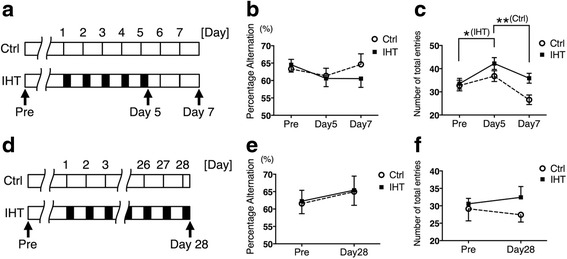Fig. 5.

Effects of intermittent hypoxia treatment (IHT) on behavior on Y-maze tests. a-c Effect of IH5D on the Y-maze test. a Schedule of Y-maze tests. Black boxes indicate IHT, and white boxes indicate normoxia treatment. b Percentage alternation is shown by the broken line with open circles (Ctrl) and by the solid line with closed squares (IHT). Data include the mean + SEM (Ctrl, n = 14) and mean - SEM (IHT, n = 14). c Number of total entries is shown by the broken line with open circles (Ctrl) and by the solid line with closed squares (IHT). Data include the mean ± SEM (Ctrl, n = 14; IHT, n = 14). * p <0.05, ** p <0.01. Abbreviations: Ctrl = control group, IH5D = exposed to IHT for 5 days, IH5DR2 = exposed to IHT for 5 days, followed by normoxia treatment for 2 days. d-f Effect of IH28D on the Y-maze test. d Schedule of Y-maze tests. Black boxes indicate IHT, and white boxes indicate normoxia treatment. e Percentage alternation is shown by the broken line with open circles (Ctrl) and by the solid line with closed squares (IHT). Data include the mean - SEM (Ctrl, n = 7) and mean + SEM (IHT, n = 7). f Number of total entries is shown by the broken line with open circles (Ctrl) and by the solid line with closed squares (IHT). Data include the mean - SEM (Ctrl, n = 7) and mean + SEM (IHT, n = 7). Abbreviations: Ctrl = reared at our institution for 28 days, IH28D = exposed to IHT for 28 days
